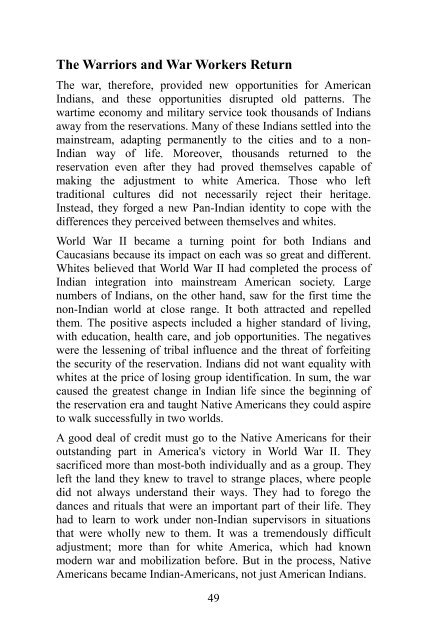used first <strong>in</strong> late 1942 on Guadalcanal. Special Code Talker unitswere eventually assigned to each of the Mar<strong>in</strong>e Corps' six Pacificdivisions. By war's end, over 400 Navajo had served as CodeTalkers. Untold numbers of Mar<strong>in</strong>es owe their lives to the NavajoCode Talkers.Indians also excelled at basic tra<strong>in</strong><strong>in</strong>g. Maj. Lee Gilstrop ofOklahoma, who tra<strong>in</strong>ed 2 ,000 <strong>Native</strong> <strong>Americans</strong> at his post, said,"The Indian is the best damn soldier <strong>in</strong> the Army." Their talents<strong>in</strong>cluded bayonet fight<strong>in</strong>g, marksmanship, scout<strong>in</strong>g, andpatroll<strong>in</strong>g. <strong>Native</strong> <strong>Americans</strong> took to commando tra<strong>in</strong><strong>in</strong>g; after all,their ancestors <strong>in</strong>vented it. One Sioux soldier, Kenneth Scisson ofSouth Dakota, became an American commando unit's lead<strong>in</strong>gGerman-killer. On a s<strong>in</strong>gle patrol, Scisson added ten notches tohis Garand rifle. <strong>Native</strong> <strong>Americans</strong> endured thirst and lack of foodbetter than the average soldier. They had an acute sense ofperception and excellent endurance, along with superior physicalcoord<strong>in</strong>ation.Indians first saw action <strong>in</strong> the Pacific theater. Over 300 Indians,<strong>in</strong>clud<strong>in</strong>g a descendant of the famed Apache chief Geronimo, tookpart <strong>in</strong> the defense of Bataan and Corregidor. Over 2,000 Indianfarmers, workers, and bus<strong>in</strong>essmen <strong>in</strong> Oklahoma and NewMexico tra<strong>in</strong>ed and fought as part of the 45th Infantry Divisionfor 511 days of combat <strong>in</strong> Italy and Central Europe. The"Thunderbirds" had the highest proportion of Indian soldiers ofany division, but Indians served conspicuously <strong>in</strong> the 4th and 88thDivisions, the l9th and 180th Infantry Regiments, and the 147thField Artillery Regiment, and <strong>in</strong> sundry Oklahoma NationalGuard units.For <strong>Native</strong> <strong>Americans</strong>, <strong>World</strong> <strong>War</strong> <strong>II</strong> signaled a major break fromthe past. Many Indians <strong>in</strong> the military made a decent liv<strong>in</strong>g for thefirst time <strong>in</strong> their lives. By 1944, the average Indian's annual<strong>in</strong>come was $2,500, up two and one-half times s<strong>in</strong>ce 1940.Military life provided a steady job, money, status, and a taste ofthe white man's world. Indians learned assertiveness they coulduse <strong>in</strong> their fight for equal rights after the war.48
The <strong>War</strong>riors and <strong>War</strong> Workers ReturnThe war, therefore, provided new opportunities for AmericanIndians, and these opportunities disrupted old patterns. Thewartime economy and military service took thousands of Indiansaway from the reservations. Many of these Indians settled <strong>in</strong>to thema<strong>in</strong>stream, adapt<strong>in</strong>g permanently to the cities and to a non-Indian way of life. Moreover, thousands returned to thereservation even after they had proved themselves capable ofmak<strong>in</strong>g the adjustment to white America. Those who lefttraditional cultures did not necessarily reject their heritage.Instead, they forged a new Pan-Indian identity to cope with thedifferences they perceived between themselves and whites.<strong>World</strong> <strong>War</strong> <strong>II</strong> became a turn<strong>in</strong>g po<strong>in</strong>t for both Indians andCaucasians because its impact on each was so great and different.Whites believed that <strong>World</strong> <strong>War</strong> <strong>II</strong> had completed the process ofIndian <strong>in</strong>tegration <strong>in</strong>to ma<strong>in</strong>stream American society. Largenumbers of Indians, on the other hand, saw for the first time thenon-Indian world at close range. It both attracted and repelledthem. The positive aspects <strong>in</strong>cluded a higher standard of liv<strong>in</strong>g,with education, health care, and job opportunities. The negativeswere the lessen<strong>in</strong>g of tribal <strong>in</strong>fluence and the threat of forfeit<strong>in</strong>gthe security of the reservation. Indians did not want equality withwhites at the price of los<strong>in</strong>g group identification. In sum, the warcaused the greatest change <strong>in</strong> Indian life s<strong>in</strong>ce the beg<strong>in</strong>n<strong>in</strong>g ofthe reservation era and taught <strong>Native</strong> <strong>Americans</strong> they could aspireto walk successfully <strong>in</strong> two worlds.A good deal of credit must go to the <strong>Native</strong> <strong>Americans</strong> for theiroutstand<strong>in</strong>g part <strong>in</strong> America's victory <strong>in</strong> <strong>World</strong> <strong>War</strong> <strong>II</strong>. Theysacrificed more than most-both <strong>in</strong>dividually and as a group. Theyleft the land they knew to travel to strange places, where peopledid not always understand their ways. They had to forego thedances and rituals that were an important part of their life. Theyhad to learn to work under non-Indian supervisors <strong>in</strong> situationsthat were wholly new to them. It was a tremendously difficultadjustment; more than for white America, which had knownmodern war and mobilization before. But <strong>in</strong> the process, <strong>Native</strong><strong>Americans</strong> became Indian-<strong>Americans</strong>, not just American Indians.49
- Page 3 and 4: PATHFINDERa conversation with Buck
- Page 5: CONTENTS20 th Century WarriorsNativ
- Page 9 and 10: A Long Tradition Of ParticipationAm
- Page 11 and 12: Native Americans As WarriorsAs the
- Page 13 and 14: what war was like. We talked about
- Page 17: “That Is the Way It Is”a conver
- Page 20 and 21: and this one only as a favor to his
- Page 22: could do it. It hits me something f
- Page 25: We trained in England with the Engl
- Page 28 and 29: somewhere between there we met the
- Page 30 and 31: helped me to keep going; you would
- Page 32 and 33: Of course he passed away. One of hi
- Page 34 and 35: to go and even talk to one of them
- Page 36 and 37: can teach me something. If I just l
- Page 39: Native Americansin World War IIby T
- Page 42 and 43: Distinguished Service Crosses, and
- Page 44: America's call for soldiers because
- Page 47: The Indian Service sent 1,119 of it
- Page 51 and 52: Oklahoma Comanche Indians to be par
- Page 53 and 54: PathfindersConcept and TrainingTo a
- Page 55 and 56: either its amber halophane lights o
- Page 57 and 58: The 82 nd Airborne During World War
- Page 59 and 60: Once the beachhead was secured, the
- Page 61 and 62: parachute infantry regiments and re
- Page 63 and 64: penetration in the American lines.
- Page 66 and 67: The material in this pamphlet was c
- Page 69 and 70: Indians in the WarHonor for Indian
- Page 71 and 72: Honor for Indian HeroismThe war has
- Page 73 and 74: Distinguished Flying CrossThe highe
- Page 75 and 76: withering fire into the enemy, infl
- Page 77 and 78: cool courage and outstanding abilit
- Page 79 and 80: Then he solemnly shook the proffere
- Page 81 and 82: concrete that was once considered a
- Page 83 and 84: New York, made a similar jump and l
- Page 85 and 86: Foresight and Sound DecisionThe Bro
- Page 87 and 88: Pvt. Vincent Hunts HorsesSioux, Sou
- Page 89 and 90: S/Sgt. Glenn Black Quilleute, Washi
- Page 91 and 92: Donald O'NealSgt. Bert H. Jefferson
- Page 93 and 94: Ceremonial Dances in the Pacific(On
- Page 95 and 96: A Choctaw Leads the GuerrillasIn Ap
- Page 97 and 98: transport, but it was safer and eas
- Page 99 and 100:
We Honor These DeadArizonaLonnie Al
- Page 101 and 102:
Adam Harney Thomas Throssell Regina
- Page 103 and 104:
MinnesotaDaniel McKenzie Chippewa H
- Page 105 and 106:
Clarence L. Marengo Flathead ItalyE
- Page 107 and 108:
Louis M. Charlo Patrick Reevis Fran
- Page 109 and 110:
Clarence Murphy Cherokee U.S.A.Josh
- Page 111 and 112:
Sam Fixico Seminole MediterraneanJo
- Page 113 and 114:
William Sixkiller, Jr. Cherokee Sai
- Page 115 and 116:
Norman Portwood Sioux (Pine Ridge)
- Page 117 and 118:
Alpheus Decorah WinnebagoGeorge N.
- Page 119 and 120:
"hidden" languages; it is termed "h
- Page 121 and 122:
communications work. It was difficu
- Page 123 and 124:
Navajo code talker and said,"O.K.,
- Page 125 and 126:
A second Indian, Louis C. Charlo, F
- Page 127 and 128:
Wounded in ActionPaul Hendricks Pap
- Page 129 and 130:
Fred W. ScottHoopaAlbert BartowKlam
- Page 131 and 132:
Shuman Shaw Joseph R. Johnson Verne
- Page 133 and 134:
William Good Raymond F. Roberts Sam
- Page 135 and 136:
William J. Naranjo Navajo SicilyNed
- Page 137 and 138:
Duncan Suitza Zuni EuropeTelesfor T
- Page 139 and 140:
Rubin Bent Quapaw-Cheyenne EuropeOl
- Page 141 and 142:
Esra H. Wallace ChoctawJ.D. Walker
- Page 143 and 144:
Theodore Buffalo Otoe ItalyErnest J
- Page 145 and 146:
Ambrose Antelope Sioux (Standing Ro
- Page 147 and 148:
Martin Slow Bear Sioux (Pine Ridge)
- Page 149 and 150:
Roger Chasing Horse Sioux (Rosebud)
- Page 151 and 152:
Warren Swamp Oneida ItalyAbraham We
- Page 153 and 154:
Indians Work for the NavyBy Lt. Fre
- Page 155 and 156:
Indians unload Oregon timber at the
- Page 157 and 158:
To the Indian VeteranThe Congress a
- Page 159 and 160:
with your study program, your allow
- Page 161 and 162:
according to the conditions under w
- Page 163 and 164:
Indian Women Work for VictoryIndian
- Page 165 and 166:
Three Indian girls in the Women's R
- Page 167 and 168:
Among the American prisoners releas
- Page 169 and 170:
A Family of BravesSix grandsons of
- Page 171 and 172:
Indian Service Employees in the War
- Page 173 and 174:
Native AmericanMedal of Honor Recip
- Page 175 and 176:
BARFOOT, VAN T.Rank and organizatio
- Page 177 and 178:
Johnston came under straddling Japa
- Page 179:
his own initiative he left the plat




